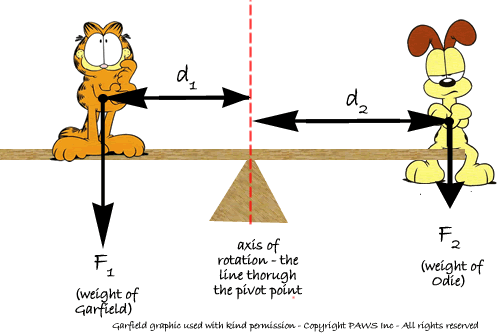The Principle of Moments
The Principle of
Moments: for a body in equilibrium
(balanced!) the sum of the clockwise moments is equal to the sum of the
anticlockwise moments.
 clockwise moments =
clockwise moments =  anticlockwise
moments
anticlockwise
moments

Garfield has considerably more weight than Odie - so for them to 'teeter-totter' Odie has to sit a bigger distance away from the fulcrum. To play 'see-saw' their moments have to be equal (according to the Princlple of Moments):
F1d1 = F2d2
As Odie has less weight (force) he needs more distance!
How to tackle questions:
 Draw a diagram and mark on all of the information you have been given and allocate the unknown a symbol (usually F or d) - in an examination annotate the one on the paper.
Draw a diagram and mark on all of the information you have been given and allocate the unknown a symbol (usually F or d) - in an examination annotate the one on the paper.
 Identify the 'pivot point', 'turning point' or fulcrum - the point around which the whole system turns.
Identify the 'pivot point', 'turning point' or fulcrum - the point around which the whole system turns.
 Identify all of the forces acting.
Identify all of the forces acting.
- If they act through the support you can ignore them (as the support will produce a reaction force that will cancel them out!)
- You may have to calculate some of the forces as they may not be given to you - you may be given 'mass' instead of weight, for example.
 Calculate the perpendicular distance from each of the forces to the turning point - in advanced level questions you are rarely given the correct distance!
Calculate the perpendicular distance from each of the forces to the turning point - in advanced level questions you are rarely given the correct distance!
 Work out all of the clockwise moments and add them together
Work out all of the clockwise moments and add them together
 Work out all of the anticlockwise moments and add them together
Work out all of the anticlockwise moments and add them together
 State the Principle of Moments
State the Principle of Moments
 Equate the clockwise and anticlockwise moments
Equate the clockwise and anticlockwise moments
 Find the unknown
Find the unknown
 Check that this unknown is actually the value you are asked for in the question - sometimes they ask you for a distance that requires this information before you can do the last step!
Check that this unknown is actually the value you are asked for in the question - sometimes they ask you for a distance that requires this information before you can do the last step!
 Check that you have included the correct unit in your answer and that it is to the correct number of significant figures.
Check that you have included the correct unit in your answer and that it is to the correct number of significant figures.
Here is a link to a video to make you think about moments:

 Click here to look at stability
Click here to look at stability
 Here is a link to a sample question on moments.
Here is a link to a sample question on moments.
 This is an interactive PowerPoint for you to work through
This is an interactive PowerPoint for you to work through
 Try this interactive puzzle or this one!
Try this interactive puzzle or this one!
Questions









